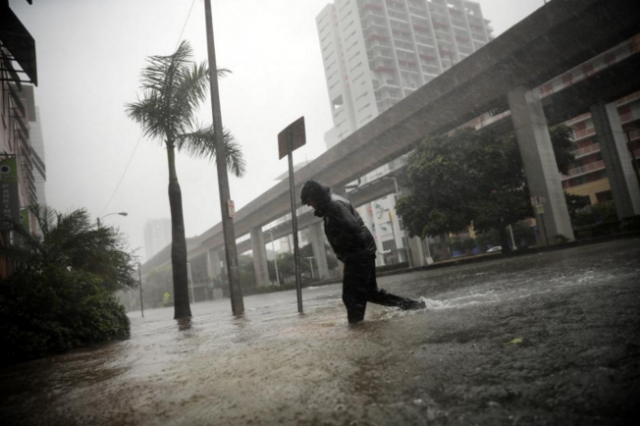
FORT MYERS/MIAMI — Hurricane Irma lashed the Gulf Coast of Florida with the brunt of its fury on Sunday afternoon, knocking out electricity to 2.5 million homes and businesses statewide while flooding streets and swaying skyscrapers in Miami.
Hours after barreling across the resort archipelago of the Florida Keys, the storm crept up the western shore of the Florida Peninsula to make a second landfall at Marco Island around 3.35 ET (1935 GMT), about a dozen miles south of upscale beach town Naples on the Gulf of Mexico.
Irma’s eye wall came ashore not long after it was downgraded from a Category 4 to a Category 3 storm on the five-point Saffir-Simpson hurricane scale, with maximum sustained winds of 120 miles per hour (195 mph).
Forecasters warned that Irma remained extremely dangerous as the monster storm toppled trees and power lines, peeled tiles off roofs and threatened coastal areas with storm surges of up to 15 feet (4.6 m). Tornadoes were also spotted through the southern part of the state.
Some 6.5 million people, about a third of the state’s population, had been ordered to evacuate southern Florida as the storm approached.
“This is a life-threatening situation,” Governor Rick Scott told a press conference. Curfews were declared on Sunday evening for the Gulf Coast towns of Tampa and St. Petersburg as several Florida counties reported arrests of looters taking advantage of homes left vacant by evacuations.
The storm killed at least 28 people as it raged through the Caribbean en route to Florida. On Sunday, Irma claimed its first U.S. fatality – a man found dead in a pickup truck that had crashed into a tree in high winds in the town of Marathon, in the Keys.
The storm’s westward tilt as it advanced on Florida put a string of Gulf Coast cities at greatest risk and spared the densely populated Miami area the full force of its wrath. The state’s biggest city, situated about 100 miles (160 km) east of Irma’s core, was anything but unscathed.
Miami apartment towers swayed in the high winds, two construction cranes were toppled, and small white-capped waves could be seen in flooded streets between Miami office towers.
Tampa and Hurricane bays experienced extraordinarily low tides that left sea life visible and boats grounded, though forecasters warned the storm would soon drive those waters back in with storm surges along the state’s Gulf Coast.
Last week, Irma had ranked as one of the most powerful hurricanes ever documented in the Atlantic, one of only a handful of Category 5 storms known to have packed sustained winds at 185 miles per hour or more.
Before turning on Florida, the storm pummeled Cuba with 36-foot-tall (11 meter) waves after ravaging several smaller Caribbean islands.
Its core was located about 5 miles (8 km)north of Naples by 5 p.m. ET (2100 GMT) and was expected to move along or over Florida’s western coast through the afternoon and evening.
Irma is expected to cause billions of dollars in damage to the third-most-populous U.S. state, a major tourism hub with an economy that generates about 5 percent of U.S. gross domestic product.
About 2.5 million Florida homes and businesses had lost power, according to Florida Power & Light and other utilities.
MIAMI BUILDINGS SWAY, STREETS FLOODED
Waves poured over a Miami seawall, flooding streets waist-deep in places around Brickell Avenue which runs a couple of blocks from the waterfront through the financial district and past consulates. High rise apartment buildings were left standing like islands in the flood.
One woman in Miami’s Little Haiti neighborhood delivered her own baby because emergency responders were unable to reach her, the city of Miami said on Twitter. Mother and infant were later taken to a hospital, it said.
Deme Lomas, who owns Miami restaurant Niu Kitchen, said he saw a crane torn apart by winds and dangling from the top of a building.
“We feel the building swaying all the time,” Lomas said in a phone interview from his 35th-floor apartment. “It’s like being on a ship.”
On Marco Island, 67-year-old Kathleen Turner and her husband rode out the storm on the second floor of a friend’s condominium after failing to find a flight out. She feared for her canal-facing home.
“I‘m feeling better than being in my house, but I‘m worried about my home, about what’s going to happen,” Turner said.
Irma comes just days after Hurricane Harvey dumped record-setting rain in Texas, causing unprecedented flooding, killing at least 60 people and an estimated $180 billion in property damage. Almost three months remain in the Atlantic hurricane season, which runs through November.
U.S. President Donald Trump spoke to the governors of Alabama, Georgia, South Carolina and Tennessee on Sunday and issued a disaster declaration for Puerto Rico, which was hit by the storm last week, the White House said.




